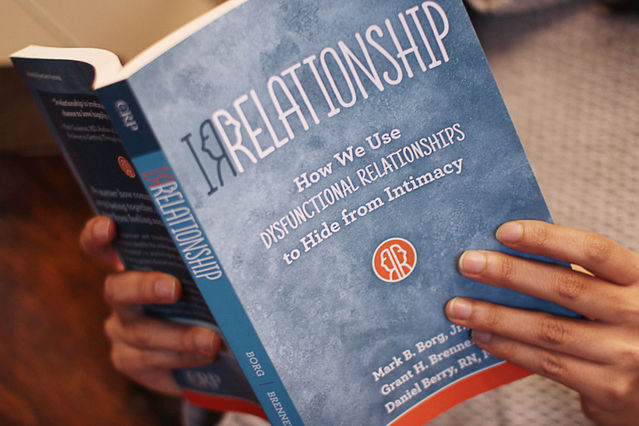Relationships
Learning to Relate
Compassionate intimacy and the road of relationship sanity
Posted May 26, 2016

Have you ever wondered if something’s tilted with how you approach relationships—something that might explain why things never turn out the way you’d hoped? Maybe it’s happened so often that you’ve even come to expect to be disappointed.
How we relate to others involves complex learned skills which we develop on top of our inborn abilities and tendencies including our ability to communicate and understand others as well as basic survival skills. And rather than reaching a plateau as we become adults, the learning continues through the lifespan.
Another factor in how we relate to others is that we unconsciously internalize “relational rules” followed by our primary caregiver and other influential persons from our early years. If those practices didn’t yield success for them, chances are the outcome will be the same for us. And even if we become aware of less-than-optimal patterns and where they came from, knowing about them probably isn’t going to be enough to change them. How we feel about ourselves, and strengths such as emotional intelligence and self-esteem, emanate from our early perceptions of parental love, especially from one’s mother (Sillick & Schutte, 2006).
The way children learn language is a good analogy for how we learn relationship patterns. Family and social groups are the “implicit” impetus for developing language skills. But children also receive “explicit” instruction through interaction with caregivers who coach us in “correct” or effective ways of communicating. Thus, the child learns to say, “I’m hungry,” rather than simply screaming. (It’s also true that mothers learn to differentiate among screams that convey genuine distress, hunger, anger at ungratified desires, or simply needing a nap.) As the caregiver’s “scream-reading” skill improves, her anxiety about parenting decreases. This leads to a reduction in the child’s anxiety as the child learns to “manage” his environment i.e., the caregiver.
Similarly, how we relate is learned from implicit messaging as well as explicit rules about, for example, what’s considered polite, acceptable, or rude. However, confusion can ensue as the child observes that, for example, certain behaviors are acceptable between adults that are not acceptable between a parent and a child. The confusion can be compounded if the child is taught that being consistent is important.
Learning how to relate to others is even more complex because it involves attention to a variety of vocabularies—verbal, behavioral and affective—that must be processed while relating to others. Further confusion may be added very early in life if a child’s parents aren’t effective caregivers, forcing the child to try to find a way to elicit the care she needs so that she feels safe.
Lessons on how to relate are likely, then, to be mixed, conflicted and confusing. And if relating means trying to make our caregivers feel good about themselves as caregivers, the child’s real needs are probably going to be neglected. This imbalance will continue to play out as we mature, so that finally, as adults we find it difficult or impossible to create integrated, adult relationships with anyone, either individuals or groups.
The authors refer to this crucial balance as relationship sanity. Relationship sanity is the natural product of learning from early childhood how to form connections with others that include a healthy balance giving and receiving.
Compassionate empathy is a model for learning and developing this kind of connection. The authors define compassionate empathy as allowing someone else's feelings and needs to inhabit our consciousness without taking over completely. It promotes ongoing health in a relationship, and even provides an environment and mechanism for “fixing” relationships that have gone awry.
Sometimes we may unconsciously create patterns of relating that distance ourselves from the people we think we’re closest to—patterns that “protect” us from what we think we want from a relationship, namely mutual emotional investment and intimacy. This kind of mutuality can be frightening when we realize how emotionally at risk it makes us. The authors call this “distancing” technique, “irrelationship.”
Irrelationship, a dissociative adaptation, is a shared coping style which allows us to distance ourselves from the anxiety related to becoming close to others. This is accomplished through a process called enactment, a habitual (but usually unconscious) acting out of behaviors intended to prevent awareness of distressing feelings. These jointly enacted behaviors, which the authors call song-and-dance-routines, stand directly in the way of resolving distress through the practice of compassionate empathy both by reproducing negative relationship experiences as well as by delaying the development of new ways of relating.
Compassionate empathy opens the door to compassionate intimacy, setting the stage for relationship sanity, a jointly created and sustained way, one day at a time, to access safely the experience of intimacy and shared vulnerability. As participants approach this new mutuality, they begin to unlock brainlock, which is the authors’ term for the psychological, neurobiological, interpersonal, and social-contextual mechanisms that underlie irrelationship.
Central to our notions of working through the irrelationship defense is our belief that health and well-being don't happen in isolation: they’re necessarily relational.
Irrelationship theory is grounded in the theory that human beings are natural-born caretakers (Searles, 1975). Prior to Searles, Bowlby (1969), the founder of attachment theory, observed that human beings have an inborn motivation to be care-seekers. We want to heal the wounds of those who are and have been sources of comfort since childhood just as we have needed them to enable us to survive. Perhaps the healing of all wounds, old and new, depends on how we learn to be with one another.
References
Bowlby John (1969). Attachment and loss: Vol. 1. New York: Basic Books.
Searles, H. (1975). The patient as therapist to his analyst. In P. Giovacchini (Ed.) Tactics and techniques in psychoanalytic therapy: Countertransference (pp. 95-151). New York: Jason Aronson.
Sillick, T. J. & Schutte, N. S. (2006) Emotional intelligence and self-esteem mediate between perceived early parental love and adult happiness. E-Journal of Applied Psychology: Emotional Intelligence. 2(2):38-48.
To order our book, click here. Or for a free e-book sample, here.
Join our mailing list: http://tinyurl.com/IrrelationshipSignUp
Visit our website: http://www.irrelationship.com
Follow us on twitter: @irrelation
Like us on Facebook: www.fb.com/theirrelationshipgroup
Read our Psychology Today blog: http://www.psychologytoday.com/blog/irrelationship
Add us to your RSS feed: http://www.psychologytoday.com/blog/irrelationship/feed

The Irrelationship Blog Post ("Our Blog Post") is not intended to be a substitute for professional advice. We will not be liable for any loss or damage caused by your reliance on information obtained through Our Blog Post. Please seek the advice of professionals, as appropriate, regarding the evaluation of any specific information, opinion, advice or other content. We are not responsible and will not be held liable for third party comments on Our Blog Post. Any user comment on Our Blog Post that in our sole discretion restricts or inhibits any other user from using or enjoying Our Blog Post is prohibited and may be reported to Sussex Publisher/Psychology Today. The Irrelationship Group, LLC. All rights reserved.




